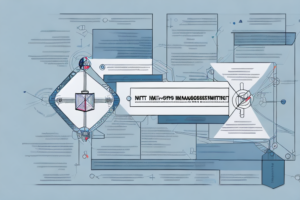What is security control reporting plan in RMF?
7 min read
A layered security system with a control reporting plan
As cyber attacks become more sophisticated, organizations must take every precaution to protect their sensitive data. One approach is the use of a security control reporting plan in the Risk Management Framework (RMF). RMF is a structured and comprehensive approach to managing cyber risk within an organization. It is based on a continuous cycle of identifying and assessing risks, implementing security controls, monitoring these controls, and then responding to identified security issues. A key element of RMF is the security control reporting plan, which enables organizations to report on the effectiveness of their security controls, measure performance, and identify areas for improvement.
Understanding the basics of RMF
RMF provides a standardized process for managing cybersecurity using established best practices and a risk-based approach. The framework consists of six steps, including:
- Categorization of information and assets to be protected
- Selection of security controls based on established standards
- Implementation of these security controls
- Assessment of the effectiveness of the controls
- Authorization to operate based on the assessed level of risk
- Continuous monitoring and maintenance of the controls
Each of these steps represents key components of security control reporting plan, as they provide the context for the security controls that will be reported upon.
One of the benefits of using RMF is that it allows organizations to tailor their cybersecurity approach to their specific needs. By categorizing their information and assets, organizations can identify the areas that require the most protection and allocate resources accordingly. This ensures that cybersecurity efforts are focused where they are needed most, rather than being spread too thin across the entire organization.
Another important aspect of RMF is the continuous monitoring and maintenance of security controls. This ongoing process helps organizations stay up-to-date with the latest threats and vulnerabilities, and make necessary adjustments to their security controls. By regularly assessing the effectiveness of their controls and making improvements as needed, organizations can better protect themselves against cyber attacks and data breaches.
The importance of security control reporting plan
Effective reporting of security controls ensures that organizations meet regulatory requirements, but it also serves to enable an organization to assess its cyber risk profile and make informed strategic decisions about security investments. Failure to report on security controls can result in significant penalties and damage to the organization’s reputation.
Furthermore, a security control reporting plan can help organizations identify potential vulnerabilities and threats, allowing them to take proactive measures to mitigate risks. By regularly monitoring and reporting on security controls, organizations can stay ahead of emerging threats and ensure that their security measures are up-to-date and effective.
Another benefit of a security control reporting plan is that it can improve communication and collaboration between different departments within an organization. By providing a clear and concise overview of security controls, stakeholders across the organization can better understand the importance of security and work together to ensure that it is a top priority.
Key components of security control reporting plan in RMF
A high-quality security control reporting plan in RMF should include:
- Identification of key stakeholders and their roles in the reporting process
- A clear and detailed description of the security controls being reported upon
- The criteria used to assess the effectiveness of security controls
- The frequency and timing of reporting
- Reporting templates and formats
- An explanation of how the data presented will be used to make decisions and drive actions
It is critical that all stakeholders understand the security control reporting plan and are trained in the process of collecting and reporting information on security controls.
Another important component of a security control reporting plan in RMF is the establishment of a feedback loop. This allows stakeholders to provide input on the reporting process and suggest improvements. It also ensures that the reporting plan remains relevant and effective over time.
Additionally, the security control reporting plan should include a process for addressing any identified deficiencies or weaknesses in the security controls. This process should outline how these issues will be addressed, who is responsible for addressing them, and the timeline for resolution.
How to develop a security control reporting plan in RMF?
Developing a security control reporting plan in RMF involves several key steps:
- Define the scope of the report and identify the security controls to be reported upon
- Establish the criteria for measuring the effectiveness of these controls, including performance goals and desired outcomes
- Identify the stakeholders and establish communication channels
- Select the reporting format and develop templates and guidelines for reporting
- Prepare the report and communicate the findings to stakeholders
The report must be timely, accurate, and provide actionable insights that enable the organization to improve its cybersecurity posture.
One important aspect of developing a security control reporting plan in RMF is to ensure that the report is aligned with the organization’s overall risk management strategy. This involves identifying the key risks that the organization faces and ensuring that the security controls being reported upon are directly addressing those risks.
Another key consideration is to ensure that the report is easily understandable by all stakeholders, regardless of their technical expertise. This may involve using visual aids such as graphs and charts to help convey complex information in a more accessible way.
Best practices for implementing a security control reporting plan in RMF
There are several best practices that organizations can employ when implementing a security control reporting plan in RMF:
- Ensure that the reporting plan aligns with the organization’s cybersecurity strategy and business objectives
- Incorporate automation to reduce manual processes and increase efficiency
- Provide training to stakeholders to ensure they understand the reporting process and know their role in it
- Regularly review and update the reporting plan to ensure it remains relevant and effective
It is also important to establish clear communication channels between the reporting team and other departments within the organization. This can help ensure that all necessary information is being collected and reported accurately. Additionally, organizations should consider implementing a system for tracking and addressing any reported security incidents or vulnerabilities. By following these best practices, organizations can effectively implement a security control reporting plan in RMF and improve their overall cybersecurity posture.
Common challenges when implementing a security control reporting plan in RMF and how to overcome them
Implementing a security control reporting plan in RMF can be challenging due to a lack of resources or a lack of understanding of the reporting process. Organizations may also struggle with data quality issues or encountering the limitations of the reporting tools they are using. To overcome these challenges, organizations should:
- Ensure that resources are allocated to complete the reporting process
- Provide training and support to individuals who lack understanding of the reporting process
- Implement data quality controls and establish policies that ensure data accuracy and completeness
- Optimize data analytics capabilities to enable more robust reporting
Benefits of having a strong security control reporting plan in RMF
A strong security control reporting plan enables organizations to:
- Meet regulatory requirements and avoid penalties
- Assess and manage cyber risks in a structured and continuous manner
- Identify areas for improvement in cybersecurity processes and controls
- Drive strategic decision-making and investments in cybersecurity
- Improve the security posture and reduce exposure to cyber threats
Real-world examples of successful security control reporting plans in RMF
Organizations across many industries have implemented security control reporting plans in RMF with great success. One such example is the Department of Defense (DoD), which has effectively implemented an RMF-based reporting plan to protect sensitive data and systems.
Measuring the effectiveness of your security control reporting plan in RMF
The effectiveness of a security control reporting plan in RMF can be measured through various key performance indicators (KPIs), including:
- The frequency of reporting
- The level of adherence to reporting guidelines and templates
- The accuracy and completeness of data
- The degree to which the reporting process results in actionable insights and improvements
Tools and technologies that can help with creating and managing a security control reporting plan in RMF
Several tools and technologies are available to support the creation and management of security control reporting plans in RMF, including automated reporting platforms and data analytics solutions. It is critical that the tools used support the specific requirements of the organization and provide the necessary functionality to capture relevant data and generate meaningful insights.
The role of automation in simplifying the process of creating and managing a security control reporting plan in RMF
Automation can significantly simplify the process of creating and managing a security control reporting plan in RMF. Automated solutions can gather data from multiple sources, streamline reporting processes, and enable real-time updates to reporting templates and formats. This not only improves the efficiency of reporting but also enhances the accuracy and completeness of data, reducing the risk of errors and omissions.
Future trends and developments in security control reporting plans for RMF
Future trends and developments in security control reporting plans for RMF are likely to include:
- Greater emphasis on automation and data analytics to improve reporting efficiency and accuracy
- Increased integration with other cybersecurity processes and frameworks, such as the NIST Cybersecurity Framework and the ISO 27001 standard
- Continued evolution of reporting standards and formats to enable more comprehensive and meaningful reporting
Tips for staying compliant with regulatory requirements through a successful security control reporting plan in RMF
To stay compliant with regulatory requirements through a successful security control reporting plan in RMF, organizations should:
- Regularly review and update their reporting plan to ensure it aligns with regulatory requirements and standards
- Ensure that the reporting plan is communicated effectively to all stakeholders
- Maintain accurate and complete records to support reporting processes
- Provide regular training to stakeholders to ensure they remain informed of regulatory changes and updates
By implementing effective security control reporting plans in RMF, organizations can ensure that their cybersecurity processes are properly managed, optimized, and aligned with their strategic objectives and regulatory requirements.



